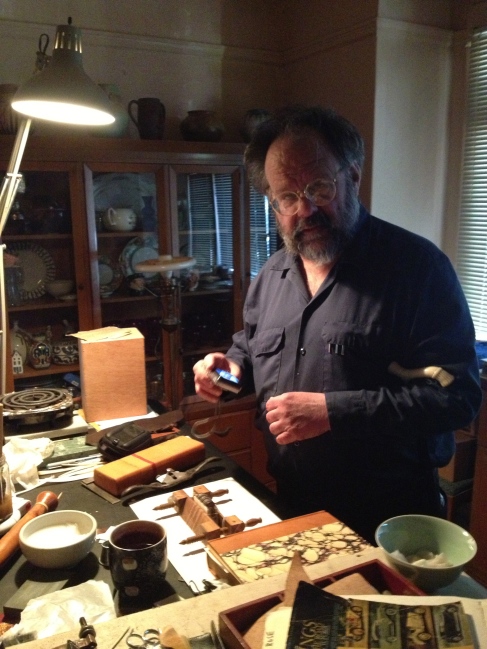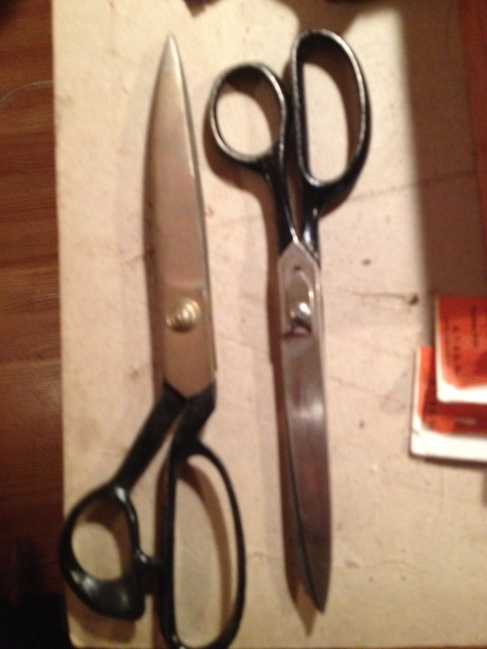Last week, I went back to the Robbins Collection again to gather more information – and take a few pix. If they give me permission to use them, I’ll write about what I found. 
I had a couple of articles borrowed from Tom Conroy, so I had to return them and had the opportunity for another visit. We started talking about a class that I plan to teach on how to look at books for book artists/craftspeople. We’ll visit a handful of rare book collections in the Bay Area, focusing on a different subject at each institution. Wooden boards & early manuscripts at the Robbins; Incunables somewhere else; and maybe a calligraphic history section at a private collection.
While we talked, Tom moved around and laid things out – he’s still working on that miniature bible and had covered it in leather. He tied it up in the miniature press and was taking pictures as we spoke.
Drawing my attention away from his main object, Tom asked a few questions about my class: How was it structured? How many institutions? Who would be attending?
As this barrage of questions pelted me, Tom kept on moving and waited as he set the trap.
And I fell right in: “Hey Tom, do you want to team teach this with me?”
He smiled that private smile of his and that is when I knew I’d walked right into it.
So now this class will be a lot more fun and informative because I was duped into adding him to the line-up.
As you can see, I’m really upset by this development. 😉
We were also talking about how the eye becomes trained to see little things and sense their significance. I had seen an incunable with an alum-tawed spine. No portion of the boards was showing, just the spine which had a part of the skin peeled away from the joint at the top. I could see some dark-colored corner exposed by the detached skin, but that was all.
I pulled it out and it was a wooden-board binding. I didn’t know what I would find.
Because I took the chance of pulling this book off the shelf, I was rewarded with finding an example I would have missed otherwise.

Tom pointed to the plane in the center of the picture you see above. He was offered a box stuffed with musty bits in exchange for helping a friend clear up a storage area. He saw about 1/2″ of the top of the handle and knew that it was a pre-war Stanley plane – and that it was worth having.
Developing an eye for things is something that comes with experience. And that’s what we want to teach in our codicology for book artists class.
Having learned by looking at a large quantity of books, tools and objects, it’s easier to pick up things quickly. I used to be amazed at how my teachers could do this pattern recognition with just a quick glance – and I thought I’d never get it.
Now, it’s second-nature.
In my previous visit, Tom was putting linseed oil on a handle that he had turned. He kept rubbing the oil into the wood – it had soaked for some time – maybe a week? He then prepped the hole at the end of the handle and took a stout sewing needle and pushed it down the hole. Wood glue and a lot of manipulation later, the needle was firmly seated in the handle. And he handed it to me to look at.
Or so I thought. He gave it to me for my own use.
I’ll get a picture of it for the next post about Tom.
The last little trick was to show me a pair of scissors as we discussed the subject of seeing things at a glance. Tom’s gifted at finding good pairs of scissors and shears at flea markets. His skill is such that he has amassed a quantity far greater than he can ever use. I suggested he sell them, and he said that was a good idea.
I asked the cost of the pair in my hand – the one on the right above – he told me that I could have them for $10.
So I bought them. And he thanked me for saving him the hassle of cleaning and sharpening them.
See? He’s a tricky binder!


